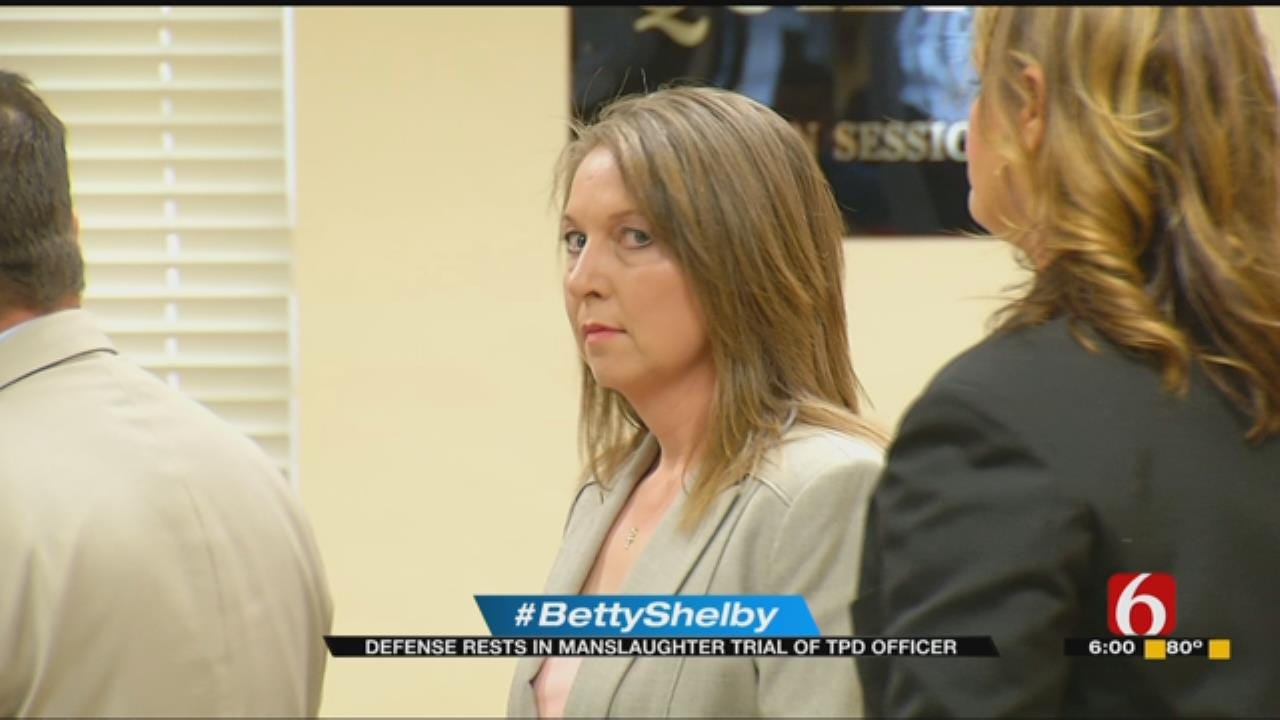Defense Rests In Betty Shelby Manslaughter Trial
<p>Betty Shelby defense attorneys rested their case shortly before noon Tuesday, day seven of the manslaughter trial.</p>Tuesday, May 16th 2017, 11:28 am
The defense has rested in the manslaughter trial of Tulsa Police Officer Betty Shelby. The jury was instructed to come back to court at 9 a.m. Wednesday for closing arguments and to decide a verdict.
Judge Doug Drummond warned them to plan on a long day.
In the day ahead
The prosecution and defense met with the judge to discuss jury instructions. On Wednesday morning, jury members will return and hear those instructions.
The prosecution will make closing arguments, then the defense. The prosecution will be able to speak one more time, in rebuttal. Then the jury will begin deliberations.
Since one juror was excused for illness, one of the two alternates will be instructed to go into the deliberation room with the other 11. They will not be allowed to leave until they reach or verdict or declare that they are deadlocked.
News On 6 will remain at the courthouse until deliberations are complete.
Day Seven of the Betty Shelby Trial
Day seven began with Betty Shelby defense attorney asking for a mistrial before the jury was brought into the courtroom.
Defense attorney Shannon McMurray said the prosecution was repeatedly implying Shelby's choice to obtain council and wait a few days to give a statement revealed her guilt. The shooting took place on a Thursday, and Shelby waited until Monday to make her statement.
McMurray said her client was merely exercising the right every citizen has, and the prosecution should not suggest to the jury that it indicates guilt.
McMurray also said the prosecution's repeated comments and questioning about Terrence Crutcher being unarmed weren't fair. She argued if the prosecution could keep saying Shelby "guessed" Crutcher had a gun, McMurray should be able to say he was seen in the same area with a gun the day before.
Judge Drummond said the fact he was unarmed is a factor in case and he has already ruled Crutcher's behavior the day before was inadmissible. He denied the mistrial.
Witness: Dr. Howard Williams, expert in use of Tasers
Dr. Howard Williams, a one-time chief of police and 36-year law enforcement veteran, was called to testify as an expert on the use of Tasers. Williams testified to how Tasers work and instances where they have proven to be ineffective - for example, if the suspect is too far away from the officer or is wearing heavy clothing.
Williams said he has investigated cases where Tasers failed and officers who chose to use a Taser instead of a gun died as a result of that choice. He said an officer would be ill advised to pull a Taser in this situation because 13 cases since 2004 where a Taser failed, the officer was killed.
The expert witness said for a Taser to effectively incapacitate someone, the probes must be in the skin or really close to the skin.
If the Taser was effectively deployed - meaning that the electrical current did work and did incapacitate the individual in some way - it should leave marks where the probes penetrated the skin.
Special Coverage: Betty Shelby Manslaughter Trial
Williams said he reviewed all the evidence into the Terrence Crutcher shooting, including the autopsy report, and those burn or Taser marks were not present according to the doctor who examined Crutcher's body. He said based on helicopter video, the medical examiner's report and photos, he doesn't believe there was effective Taser deployment on Crutcher.
According to research, Williams said Tasers fail 10 to 32 percent of the time; however, he said his expert opinion is that the failure rate is not that high. He believes they fail in more like 10 to 15 percent.
He said if he were the only officer at the scene, he would not trust his life to it. Officer Shelby was not alone at the time she shot Terence Crutcher, Officer Tyler Turnbough was present. However, Shelby testified on Monday that she was so focused on Crutcher, she did not realize Turnbough - who had his Taser drawn - was standing next to her.
District Attorney Steve Kunzweiler asked Williams if he is a medical examiner, if he was at the scene, if he saw the autopsy or if he doubts what officers at the scene said. Williams answered no.
Kunzweiler asked Williams about a "sympathetic shot" where an officer hears the pop of a Taser and mistakes it for a gunshot then fires his or her gun. Williams said the Taser and gun fired at the same time in this case, and he doesn't believe it was a sympathetic shot.
He admitted it is rare that both officers would fire at once.
Under cross-examination, Williams also admitted a Taser can be effective without marking the skin. Kunzweiler noted Taser probes landed in Crutcher's shirt and pants which is optimal placement.
The DA also pointed out Crutcher wasn't advancing, making threats or holding any weapon but had his hands in the air moments before the shooting.
Witness: Homicide Sergeant David Walker
The defense called in a few more witnesses in day seven of Betty Shelby's manslaughter trial. Tulsa Homicide Sergeant Dave Walker took the stand briefly - for the third time.
Walker said the department's protocol was followed in the way the investigation was handled. He also noted Crutcher had several outstanding warrants the night of the shooting.
When asked if he would have recommended the Shelby case for prosecution, he answered no.
Witness: Dr. David Klinger, expert in use of deadly force
Dr. David Klinger, sociologist who is an expert on deadly force, then took the stand. Klinger is an author who has written a book and many articles about deadly police encounters and has interviewed 298 officers who have used deadly force.
He also is former Los Angeles police officer who has himself taken a life.
Klinger said he reviewed evidence and videos and did a walk through of the scene with Shelby. He also told the jury he is not a paid expert witness but works for free in criminal cases.
Officers are taught to look for dangerous behaviors including threats and lack of communication. He said officers are taught to de-escalate tensions where appropriate. Sometimes, they just need to take action.
He said a suspect ignoring commands poses a higher threat to an officer. it is unusual for someone not to comply with an officer who has a gun drawn, so that is an indicator that would put an officer on higher alert.
Under those circumstances, it is appropriate for an officer to think the suspect is up to something bad.
He also spoke of "perceptual anomalies" - differences in what officers or any citizen sess when we are in a traumatic experience where you feel your life is at risk. You may have heightened sight - for example, be able to see beads of sweat on someone's face. Things may appear to be moving in slow motion or faster than normal.
You may have tunnel vision and not see anything else around you.
You may hear things very loudly or you may not hear something at all. Some officers report they did not hear their own gunshot during a shooting.
He said it is not unusual that Shelby would say she didn't hear Officer Turnbough next to her or hear him say he had his Taser. He said it was appropriate in this case for Shelby to fire her gun when Crutcher reached into the window. He said you can't afford to wait because you can be shot, that you would be gambling with your life to wait.
Prosecuting attorney Kevin Gray pointed out that Crutcher never fought Shelby, made aggressive moves or produced a gun. Gray said Shelby was "guessing" Crutcher had a weapon. Klinger said it was an "informed hypothesis."
More Like This
May 16th, 2017
January 2nd, 2025
September 29th, 2024
September 17th, 2024
Top Headlines
February 25th, 2025
February 25th, 2025
February 25th, 2025
February 25th, 2025










